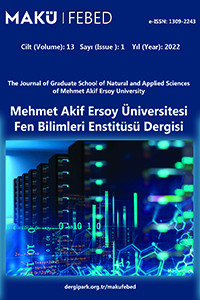Türkiye'deki Mevcut Betonarme Binaların Deprem Performansları Üzerine Bir Değerlendirme
Mevcut betonarme binalar, deprem performansı, nonliner yöntem
An Evaluation on Seismic Performance of Existing Reinforced Concrete Buildings in Turkey
___
- Celep, Z. (2014). Nonlinear behavior of reinforced concrete structural systems and analysis, Beta Press, Istanbul (in Turkish).
- Computers and Structures, Inc., (2003). SAP 2000 Nonlinear, Version 8.2.3, Structural Analysis Program, Berkeley, CA, USA.
- Dilmaç, H. (2017), Investigation of seismic safety of type of residential reinforced concrete buildings, Ph.D. Dissertation, Suleyman Demirel University, Graduate Scholl of Natural and Applied Sciences, Isparta, Turkey (in Turkish).
- Doğangün, A. (2004). Performance of reinforced concrete buildings during the May 1 2003 Bingol earthquake in Turkey. Engineering Structures. Vol. 26, No. 6, pp. 841–56.
- İnel, M., Özmen, H.B., and Bilgin, H., (2008). Re-evaluation of building damage during recent earthquakes in Turkey. Engineering Structures. Vol. 30, pp. 412–427.
- İnel, M. and Meral E., (2016), Seismic performance of RC buildings subjected to past earthquakes in Turkey. Earthquake Structure. 11(3), 483-503.
- Özcebe, G., Ramirez, J., Wasti, T.S., and Yakut, A., (2004). 1 May 2003 Bingol Earthquake. Engineering Report, At: http://www.seru.metu.edu.tr/archives/databases/ Bingol Database; Publication no:2004/1.
- TEC (2007). Turkish Earthquake Code. The Minister of Public Works and Settlement. Ankara.
- Tekeli, H., Dilmaç, H., Erkan, K.T., Demir, F., Güler, K. (2013). The effects of material properties on building performance, Proceeding of the 2th International Balkans Conference on Challenges of Civil Engineering, May 23-25, 2013, Tirana, Albania, 74-84p.
- Tekeli, H., Dilmaç, H., Demir, F., Güler, K. and Celep, Z. (2014). A simplified procedure to determine seismic performance of residential RC buildings, Proceeding of The 11th International Congress on Advances in Civil Engineering, October 21-25, 2014, İstanbul, Turkey.
- Tekeli, H., Dilmaç, H., Demir, F., Gençoğlu, M. and Güler, K. (2017). Shear stress indicator to predict seismic performance of residential RC building. Computer and Concrete. Vol.19, No.3, pp.283-291.
- Sezen, H., Whittaker, A.S., Elwood, K.J., Mosalam, K.M. (2003). Performance of reinforced concrete buildings during the August 17, 1999 Kocaeli, Turkey Earthquake, and seismic design and construction practice in Turkey. Engineering Structures. Vol. 25, No. 1, pp. 103–114.
- Sucuoğlu H., (2007). Deprem Yönetmeliği Performans Esaslı Hesap Yöntemlerinin Karşılıklı Değerlendirmesi, Türkiye Mühendislik Haberleri, 445,25-36.
- Yakut, A., Gulkan, P., Bakır, B.S., and Yılmaz, M.T., (2005). Re-examination of damage distribution in Adapazari: Structural considerations. Engineering Structures. Vol. 27, No. 7, pp. 990–1001.
- Yön, B., Sayın, E., Calayır, Y., Ulucan, Z.C., Karataş, M., Şahin, H., Alyamaç, K.E. and Bildik, A.T., (2015). Lessons learned from recent destructive Van, Turkey earhtquakes, Earthq. Struct., 9(2), 431-453.
- Yayın Aralığı: Yılda 2 Sayı
- Başlangıç: 2010
- Yayıncı: Burdur Mehmet Akif Ersoy Üniversitesi
Perovskit Güneş Hücreleri ve Kararsızlık Problemleri
Kent Kimliğinin Kent Meydanlarına Yansıması: Alanya İskele-Rıhtım Bölgesi Örneği
Ali TÜRK, Hatice Selcen SEYDİOĞULLARI
Orhan GÜNGÖR, Hüseyin Bilal MACİT, Abdülkadir ÇAKIR
Bakır Folyo Kaplı Yönlendirilmiş Yonga Levhanın Elektromanyetik Girişimi Soğurma Etkinliği
Kent Ormancılığı Faaliyetlerinin Sürdürülmesi: Çivril, Denizli Örneği
Cengiz YÜCEDAĞ, Latif Gürkan KAYA, Hüseyin Samet AŞIKKUTLU, Eşe SAĞIR
Türkiye Faunası İçin Aturus Cinsinin (Acari: Hydrachnidia) İki Yeni Türü
Antalya Havzası Akarsularındaki Yılan balığı Göçleri Üzerine Antropojenik Baskılar
Fahrettin KÜÇÜK, İskender GÜLLE, Salim Serkan GÜÇLÜ
Türkiye'deki Mevcut Betonarme Binaların Deprem Performansları Üzerine Bir Değerlendirme
Hakan DİLMAÇ, Hakan ULUTAŞ, Hamide TEKELİ, Fuat DEMİR
Pawlak Yaklaşım Uzaylarının Topolojik Yapısı ve Genelleştirilmiş Kaba Kümeler
